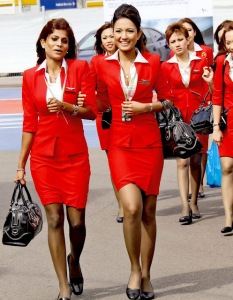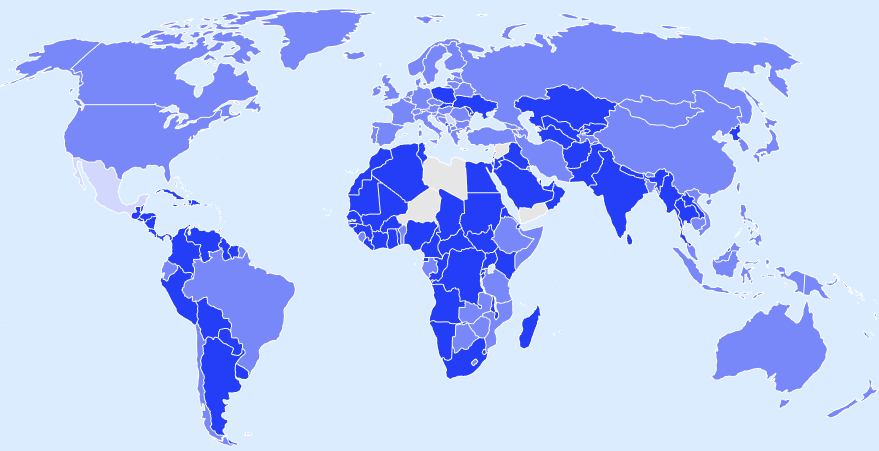Security guru Bruce Schneier invented the term “security theater” to describe the showy but time-consuming and largely ineffective security measures adopted by airports in the wake of 9/11. As passenger flights fitfully restart in the wave of COVID-19, we are starting to see the first acts of its successor, COVID theater. Here’s a breakdown of the theater’s performances, from the first stage of a journey to the closing curtain.
Stage 1: At the airport
Disinfection tunnels, booths and showers
Some airports are moving to mandate various contraptions that spray disinfectant at the hapless people passing through them, purporting to kill bacteria and viruses. These are completely ineffective at sanitizing an actually sick passenger, whose viral loads are inside the body, of dubious efficacy at preventing surface-to-surface transmission, and if anything seem likely to be hazardous to health since the disinfectants used were never designed to be inhaled. As a cherry on top, the most common ingredient is ethyl alcohol (ethanol), meaning that many Muslims, Hindus and others will justly object to breathing in the stuff. In short, these seem to be the backscatter X-rays of the COVID era: hopefully this time it’ll take less than 12 years to ditch them.
Temperature checks
Thermal scanners have long been a familiar sight for travellers to Asian airports, and they were promptly dusted off when COVID rolled around, with Canada among others poised to mandate them. While manual forehead checks are slow and error-prone — I’ve had several checkers report temperatures in the low 35s, meaning I’m apparently dying of hypothermia in tropical Singapore — those based on infrared imaging are a fast, scalable and sensible precaution. However, we now know that COVID can be infectious before there are visible symptoms like fever, meaning that these alone won’t suffice.
Preflight COVID-19 testing
The gold standard of checking whether somebody has COVID-19 is the PCR swab test, but the logistics of testing people before they can board their flights are formidable. First out of the gate was Emirates, which has kicked off mandatory COVID tests for all passengers checking in at Dubai, with results reportedly available in 10 minutes. However, based on the linked video, this is actually a serology (blood) test that can only detect past infection, not a swab test that can detect current infection, making this pure theater.
On the government level, a number of countries like Thailand require that passengers bring along a negative real (PCR) COVID-19 test result, leaving the often rather involved logistics of getting this test to the traveler. Hawaii is also following suit, and with time, as tests improve and become more easily accessible, I expect getting your brain tickled through your nose to become a sadly common pre-departure ritual. Here’s hoping saliva tests become more common.
One practical complication I’ve rarely seen mentioned is the dubious accuracy of COVID tests, with rates for both false positives (healthy but tests sick) and false negatives (sick but tests healthy) varying between 3 and 20 percent depending on who you believe. While false negatives are the bigger problem in epidemiological terms, they will be less and less common as the pandemic subsides. The problem of false positives, though, will continue: if there’s 200 people on a flight, and 5% falsely test positive, that’s 10 people having their travel plans wrecked. With one flight a day this might work, but what happens when an airline is dealing with thousands of false positives every day?
Check-in & security
Airports and airlines have been moving towards self check-in for a while now, but coronavirus has lit a fire under these efforts. However, there’s enough complexity with visa checks and luggage and such that while airlines will do their best to steer people away, the manned check-in counter will remain. Security will also continue to have humans in the loop, only with more social distancing. There are already spread-out queues spilling out of the security areas, which were never designed with this in mind, and it remains to be seen whether this can scale as volume ramps up.
Lounges
Travellers to the US used to laugh at the shrink-wrapped apples on offer in United’s famously pathetic Club lounges. Alas, it looks like COVID-19 will have the last laugh. Many lounges have been closed entirely, and in those that remain open, social distancing and capacity caps are in, while self-service buffets and drinks are out. First class lounges that offer food made to order can likely continue as is, but for the rest of us, it’s going to be brown bags and shrink wrap all the way.
Mandatory masks
Last but not least, most airports and airlines have now mandated wearing masks. This one is not theater: while the efficacy of non-medical masks in protecting the wearer remains low, even the WHO has finally come around to recommending them to help protect others from the wearer’s own infection, so expect these to stick around.
Stage 2: On board
A typical passenger airplane refreshes its entire air supply every 2-3 minutes, making its air far cleaner than (say) a meeting room. Nevertheless, more theater awaits onboard.
 Seating
Seating
A lot of ink has been expended on airlines leaving middle seats empty, which is a non-starter: no airline will agree to abandon 33% of its capacity forever, and indeed none have actually done so. A few have made disingenuous commitments about leaving middle seats empty unless the plane fills up, which was standard pre-corona practice anyway.
One more financially realistic alternative, though, is installing plexiglass dividers between seats in economy class, and one Italian company has already come up with a concept for this. No public takers yet.
Airlines like Singapore Airlines have also stopped allowing advance seat selection: you sit where you’re assigned, complete with a rather odd division of the aircraft into separate compartments for transiting and non-transiting passengers.
Reduced service
If you think passengers on an airplane have it tough, the airline crew bear the brunt of it. To cut down on the number of interactions with passengers, airlines are already cutting service left and right: no drink or meal service on shorter flights, prepackaged brown bags on longer ones. COVID is also the last nail in the coffin for duty-free shopping.
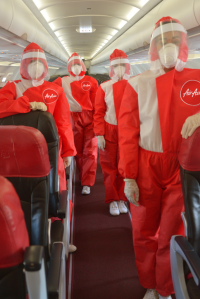
As what this means for their work uniform, these two before & after pictures from Air Asia tell a thousand words. At least the new uniform has a vaguely reassuring Santa Claus vibe to it.
Outside business class, where the extra space and privacy will be a better selling point than ever, it’s going to be really difficult for full-service airlines to compete against their low-cost brethren. This applies even more in markets like Asia, where personal service and sex appeal remain key differentiators.
No hand luggage
One of the weirder evolutions of the COVID era has been airlines restricting carry-on baggage or even eliminating it entirely. I’ve yet to hear an epidemiological justification spelled out for this, but presumably the excuse is to reduce the amount of time spent standing around shoving bags into the overhead compartments. Conveniently, the increased time spent checking in and collecting bags is the responsibility of the airport, not the airline.
And more…
Airlines, bleeding money, have taken the opportunity to cut other perks as well. Amenity kits consist only of masks and hand sanitizer, and most airlines have dropped the in-flight magazine. Emirates has eliminated limousine rides, free wifi and live TV, and Qantas has stopped serving alcohol.
Stage 3: On arrival
The real fun, though, begins on arrival, or to be quite precise, while jumping through all the hoops needed to be even permitted to fly into a country.
Border closures
As this world map from IATA shows, something like half the world remains completely closed (shaded dark blue), with no international flights at all permitted. Even the lighter blue “partially restrictive” countries are in reality entirely locked down to visitors, as the vast majority of them only permit their own citizens or residents to return.
Some of these travel restrictions made sense when they were first imposed, when you wanted to restrict transmission into a virgin territory. For the COVID-free territories like New Zealand, continuing to maintain these arguably makes sense even today. But for the vast majority of these countries, where the genie is well and truly out of the bottle within their own borders, complete closures make no sense whatsoever.
Quarantine
Since COVID-19 doesn’t care about nationality, and most countries can’t legally stop their own citizens from returning, large swathes of the world now require all incoming travelers to quarantine for 14 days. Enforcement of this quarantine varies widely: in some countries you’re taken to hotels or camps and effectively detained for the duration, while in others you can stay at home to serve your sentence, perhaps with the odd phone call to check. And if both sides require quarantine, even the shortest return trip now requires 28 days, which is a non-starter for anything short of moving countries for good.
As an aside, it’s curious how the number “14” has now become standard. It appears to originate from Chinese estimates back in January of how long it takes people to become symptomatic, and it has been unchanged ever since, even though we now know not just that most people become symptomatic in 5-6 days, but that they appear most contagious a few days before that. So odds are a 7 or 10-day quarantine would also catch 99% of infections — but what bureaucrat would dare break ranks and suggest so?
Bureaucracy and travel bubbles
As complete border closures become increasingly intolerable, various “travel bubbles”, “green lanes” and other schemes to allow tightly controlled travel are starting to sprout. As one example, here are the twelve (12) steps required to travel from Singapore to China under the “green lane” process:
- Obtain a letter of sponsorship from the relevant Chinese organisation, whether it is a government agency or business entity
- The sponsor will file an application with the local provincial or municipal authorities
- An invitation will be issued to the traveller once the application is approved
- Apply for a visa at the Chinese embassy in Singapore, if required
- Submit health declaration to the Chinese authorities
- Take a COVID-19 swab test within 48 hours before one’s scheduled flight, at one’s own cost
- Once the swab test results come back negative, the traveller can board the flight, taking the necessary precautions, such as wearing a mask at all times, even in-flight
- Take another COVID-19 swab test and a serology test, which tests for the virus’ antibodies, once one has reached China, at one’s own cost
- Remain in a quarantine location designated by the local provincial or municipal government for one to two days until the test result is out
- If tested positive, the traveller will remain in China for medical treatment at his own cost
- If the test result comes back negative, the traveller can proceed with the itinerary that was planned by his sponsor, and he must adhere to it for the first 14 days
- The traveller must use China’s local health QR code for the duration of his stay
Since this process was designed by bureaucrats, there are no commitments regarding how fast these applications will be processed, much less details about what will be considered permissible grounds for travel. Now multiply this across every pair of countries where you might want to travel, and it’s clear this will provide a much stronger brake on business travel than business visa requirements ever did.
On-arrival COVID-19 tests
As shown by the Singapore-China path above, an alternative to quarantine is mandating COVID tests on arrival. Vienna in Austria was the first airport I know of to offer this, with results in 3 to 6 hours, and quite a few places like South Korea and Iceland have now followed suit. You’re still typically detained until the test results are out, but at least you can be on your way, if not the same day then at least the following one.
My money is on this becoming the gold standard going forward, because no country is really going to trust any testing done elsewhere. It’s just too easy to fluff up, forge or bribe your way to a negative test. So expect arrival in a country to mean a smile for the camera, a digit on the fingerprint reader, and a cotton swab up your nostril.
Movement restrictions
But after you’re through the gauntlet, are you finally free? If Japan’s proposals come to fruition, not really: despite successfully passing through all these hoops, business travellers permitted into the country will be restricted their hotels and offices/factories, with use of public transport off limits. The mind boggles at how the bureaucracy can delineate what is permissible and not (customer offices? shopping malls? restaurants?), much less how they expect to enforce this.
Most other countries, such as (once again) South Korea, are outsourcing the job to technology: instead of trying to proactively limit where they can go, they just require foreign visitors to install a tracking app, so their movements can be traced afterward.
Is all this theater worth it?
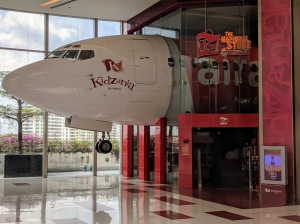
For the first, the sheer weirdness of being crammed elbow to elbow with strangers in a tin can hurtling through the troposphere for hours on end causes anxiety in many people at the best of times. Now mix in the fear of catching an (occasionally) lethal disease and you can see why people are freaked out. Airline travel is also one of few venues left where the 1% have to rub shoulders with the hoi polloi on fairly equal terms, meaning that legislators, a frequent-flying bunch, are directly incentivized to promote “safety”, certainly when compared to, say, worrying about working conditions at an abattoir. And America being America, airlines are fully aware that if they follow anything less than best practice, they leave themselves open to lawsuits. So if any one airline rolls out a safety measure, no matter how cumbersome or pointless, all others now face pressure to adopt it too, or risk having it used as legal ammo against them.
For international travel, though, the primary driver for these restrictions is the same as it is for security theater, namely politics. In the same way that nobody wanted to be seen to be soft on terrorists after 9/11, letting “diseased foreigners” into your country is electoral kryptonite, and we’ve already seen that while these restrictions were quick to ratchet up, they will take a long time to wind down. (Fun fact: Richard Reid tried to blow up a plane with his shoe in 2001, and the TSA is still peeling off everybody’s sneakers almost 20 years later.)
So how big are the risks? For on-board transmission, we know that with the original SARS, there was one well-known flight that saw at least 16 people get infected. Yet to date there seem to be no signs that travel would be unusually risky: for example, the superspreaders events database at time of writing contains zero (0) known superspreading events within an airplane or an airport. I’m no epidemiologist, but these 511 people interviewed by the New York Times are, and they figure that a flight is slightly riskier than a haircut, but slightly less risky than riding a bus or subway.
(Update: There has been at least one superspreading incident on an airplane now, namely case #17 in Vietnam, who appears to have infected at least 10 people on the same London-Hanoi flight.)
As for preventing COVID-19 from spreading at the destination, this is a clearer risk, and in the early stages of the pandemic the virus obviously spread from country to country by airplane. The limiting factor for safety measures on this front is alternative methods of travel: if there’s nothing preventing you from driving from New York to Miami, or Frankfurt to Malaga, there’s not a lot of point to swab testing or quarantining flyers. So here too it’s the locked down island nations like New Zealand, Australia and Japan, where arriving by air is the only realistic option, that seem likely to insist on the tightest measures for the longest.
Last year, I clocked 150,000 miles on a plane. This time, it’s not looking likely that I’ll be on a plane again before the end of the year.

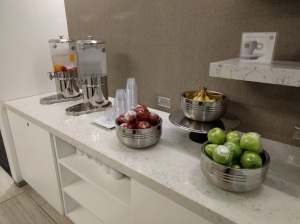
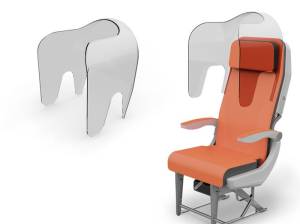 Seating
Seating